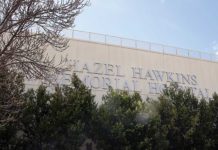The family tree is gone, but historic roots remain
The text from my dad caught me a bit off guard, both for the
news it contained and the surprise it elicited when I read it.
He said that a gnarled old pepper tree at the Castro-Breen Adobe
at the San Juan Bautista State Historic Park had been cut down, and
he jokingly noted that they didn’t bother asking him for permission
before felling it.
The family tree is gone, but historic roots remain
The text from my dad caught me a bit off guard, both for the news it contained and the surprise it elicited when I read it.
He said that a gnarled old pepper tree at the Castro-Breen Adobe at the San Juan Bautista State Historic Park had been cut down, and he jokingly noted that they didn’t bother asking him for permission before felling it.
The fact that the historic house on the west end of the Mission Plaza was owned by my ancestors from 1849 to 1933, before it became part of the state historic park, was not the reason that news of the tree’s removal bothered me. I never lived there; I didn’t plant the tree.
The news got to me because the tree at the corner of Second and Washington streets was called “our tree” by my sons. They would always climb into it when we visited San Juan to eat or window shop and we would invariably take pictures of them sitting in its wide and welcoming arms.
They thought it was cool that their last name was on a historical marker near the tree, and that must have been the genesis of their claimed ownership of the behemoth. Its wide base and sloping branches almost made it look like a huge hand, with a palm that was easy to climb into and large fingers that were perfect for reclining and posing for a picture.
Photos from the 1970s show the tree towering over the south side of the adobe’s tile roof and a picture from the early 1930s shows what looks to be the same tree in its younger years.
A representative at the historic park museum said the tree was cut down about a month ago, noting that it was dying from a fungus and had become a hazard to the public.
I drove to San Juan to check it out for myself on Wednesday morning and was taken aback by the starkness of the scene. A wide stump was all that remained of the tree, leaving the adobe wall behind it exposed, barren and bright.
The state park employee said the stump would not be removed, as it, too, has faded into history in a city rich with it.
“A lot of people have taken pictures of it,” she said. “We’ve had bands take pictures in front of it when it was fully bloomed.”
Another pepper tree stump still remains behind the adobe, showing the footprint of what was believed to be a tree that lived to be 150 years old.
Along Washington Street in front of the building, yet another pepper tree clings to life, a survivor of decades of rain, wind, earthquakes, and even a lightning strike that hollowed out its core but did not knock it down.
I admit it’s a bit odd to get sentimental over a tree, particularly since I don’t get sentimental about the trees that were cut down to build my house or to make the logs I burn in my fireplace in the winter.
“Our tree” was different, I guess, because it was something that was a part of my boys’ childhood. It was a must-stop place every time we visited the Mission City; a cool place to climb; a link – by location, if nothing else – to their heritage.
We will likely take another picture of the boys, now on the verge of being young men, sitting atop the stump next time we visit San Juan. Its welcoming branches are gone and only its base remains, but its roots are still there.
I guess there’s a message there.
The tree that was the setting of so many pictures of my boys as they were growing up is gone, but the memories remain. No longer can we see its huge canopy or stand under its shade. We still have our pictures and, more importantly, we still have our memories of the simple joy boys get from climbing a tree.
The tree – our tree – may be gone and the Mission Plaza looks different because of it. But history is about recognizing roots; and those remain.
Adam Breen writes a blog at http://thebreenblog.blogspot.com and teaches newspaper and yearbook classes at San Benito High School. He is a reporter at The Pinnacle and is former editor of the Free Lance.






